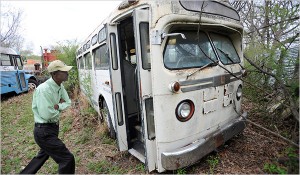The New York Times recently published an interesting piece about Worcy Crawford, a black man who owned his own bus company in segregated Birmingham, Alabama. (via: Orin)
Mr. Crawford’s work was simple. He kept a segregated population moving. Any Birmingham child who needed a ride to school, a football game or a Girl Scout outing during the Jim Crow era and beyond most likely rode one.
So did people heading to dozens of civil rights rallies — including the 1963 March on Washington where Dr. King delivered his “I Have a Dream” speech — during a time when chartering a bus from a white-owned company was impossible and driving past the city limits was dangerous for a busload full of African-Americans.
Worcy Crawfrord died last year, at the age of 90. Fortunately his son, Donald, has written a book about his long-unacknowledged contributions to Alabama’s civil rights and transportation history. The book is not widely available (if you don’t live in Alabama, Amazon is pretty much the only option), but (SPL-checkout or no) I’m definitely going to read it. The Wheels of the Birmingham Civil Rights Movement will make its way to the top of my bus reading queue before the end of 2011.
Thanks, Orin.

